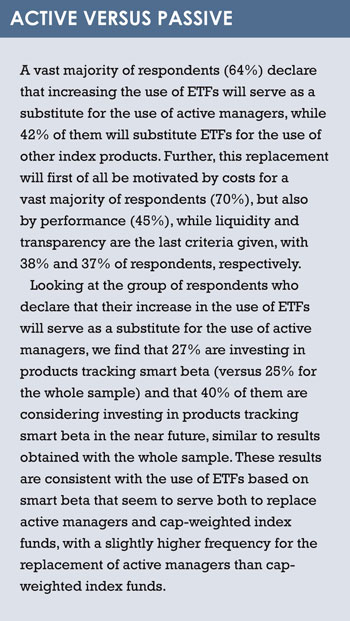The increasing variety of bond ETFs and competition among providers has given investors ample room to choose high-quality products, says Felix Goltz of the Edhec-Risk Institute. Meanwhile, more investors are replacing active managers with ETFs.
Satisfaction with standard exchange-traded funds (ETFs) has generally remained at high levels, especially for traditional asset classes, according to the eighth Edhec-Risk Institute survey on the usage and perceptions of ETFs.
Equity, government bond and corporate bond ETFs exhibit satisfaction rates higher than or equal to 90%, our research – supported by Amundi ETF & Indexing – finds. While the equity ETF satisfaction rate has been consistently in the region of 90% since our first survey, satisfaction rates for bond ETFs, in particular corporate bond ETFs, have increased considerably over time. The government bond ETF satisfaction rate has moved in a range of 80% to 90%.
For corporate bonds, the lowest value was observed in 2009, with a satisfaction rate of 61%. Since then, an increase in the rate of satisfaction from year to year was observed to stabilise at around 90% since 2013. Both corporate bond and government bond ETFs satisfaction rates are now similar to those obtained by equity ETFs. With a satisfaction rate of 94%, government bond ETFs obtain the highest rate of satisfaction among all categories of ETFs this year, closely followed by equity ETFs, with a satisfaction rate of 91%, and corporate bond ETFs, with a satisfaction rate of 90%.
Without doubt, the increasing variety of products and the increasing competition among providers concerning bond ETFs, and especially corporate bond ETFs, have given investors ample room to choose high-quality products.
ALTERNATIVE ASSETS
On the other hand, satisfaction rates for alternative asset class ETFs are either much lower, such as that of commodities ETFs (72%), or much more unstable over time, such as those of real estate ETFs and infrastructure ETFs – even though the latter two achieve quite a high satisfaction rate this year (90% and 86% respectively) – or both lower and unstable, such as that of hedge fund ETFs (62%), which this year reaches one of its highest levels of satisfaction for the period.
The rate of satisfaction for infrastructure ETFs is more variable, with high figures in 2010, 2012 and 2014 (95%, 83% and 86% respectively) and lower figures in 2011 and 2013 (67% for both). It should be noted that the sample of respondents to say whether they were satisfied or not with infrastructure ETFs was very small, with only seven respondents this year and six in 2013. As a result, the impact of a single respondent changing his mind since last year has a considerable impact on the result.
Hedge fund and real estate ETFs have exhibited variations in satisfaction rates between 30% and 60%, and 50% and 95% respectively over the past eight years. However, for real estate, higher rates of satisfaction are observed since 2010, as no rate of satisfaction lower than 83% has been observed since then. Regarding hedge funds, the sample of respondents to say whether they were satisfied or not with ETFs was also quite small, with only 12 respondents in both 2013 and 2014.
The volatility in the satisfaction rates with ETFs based on the most illiquid asset classes may also be due to the suitability of ETFs for more liquid asset classes or the fact that investor expectations are still adjusting with regard to the benefits and drawbacks of ETFs based on those asset classes. For instance, in the same year that we observe a decrease in the use of ETFs within the hedge fund and infrastructure asset classes, we also observe a considerable increase in the satisfaction rate, which may indicate that dissatisfied users have stopped using ETFs for these asset classes.
Satisfaction rates for ETFs based on the most liquid asset classes are far more consistent compared to those based on illiquid asset classes. These results suggest the existence of challenges faced by product providers in replicating indices or finding relevant indices for illiquid asset classes.

In particular, while long-only (and thus easy-to-implement) exposure to standard asset classes such as stocks and bonds provides access to a number of well-documented risk premia (such as the equity risk premium for stocks, and the credit and term premium for bonds), many alternative asset classes do not necessarily give access to risk premia through long-only investing. For example, it has been argued that long/short positions in commodity futures are necessary to capture risk premia in commodity markets, while long-only exposure to commodity prices is not expected to give rise to any risk premium.
PROSPECTS OF FURTHER USAGE
Another interesting result from our survey is that respondents plan to further increase their use of ETFs. We note that the percentage of respondents who plan to increase ETF usage is stable over time at around 60% since 2011. In addition, in 2014, almost two-fifths of respondents will maintain their level of usage of ETFs, and only 3% of respondents declare that they will reduce their use of ETFs.
Moreover, this interest in increasing ETF usage can be contrasted with the lower percentage of investors who plan to increase their usage of other instruments, such as futures and index funds (about 20% for both), or total return swaps (TRS, about 10%). It thus appears that ETFs not only benefit from increasing interest in index investments, but also that ETF users plan to favour ETFs over other indexing instruments such as futures.
THE HIGH-QUALITY TRACKING OF ETFS
Nearly 100% of respondents say ETF tracking quality is very good or fairly good, a similar percentage to 2013. It should be noted that respondents were only asked about tracking error.
The tracking quality of ETFs may be characterised by several indicators, including not only the tracking error but also the tracking difference.
Bonelli (2014) shows that depending on whether we consider the level of tracking error or the level of tracking difference, the ranking of ETFs tracking the same index may differ greatly. Considering a collection of five ETFs tracking the MSCI World Index, he observes that tracking error varies significantly across the different ETFs tracking the same index (from 0.02% to 0.22%).
The ETF with the lowest tracking error with regard to the index has one of the highest tracking differences (-0.42%), and thus greatly underperforms its benchmark, while an ETF which has one of the highest tracking errors (0.21%) is also the one with the lowest tracking difference (-0.19%).
Similar results were obtained for the MSCI Emerging Markets Index and the MSCI Europe Euro Index. Bonelli concludes that tracking error is not representative of the under or outperformance of ETFs with respect to their benchmark, but serves first of all to evaluate the relative risk of daily deviations and is of more concern for short-term than mid-term or long-term investors.
Long-term investors may be more interested in tracking difference, as its level provides information about ETF costs. Indeed, if ETF replication was perfect, the tracking difference would be equal to the ETF expense ratio. Thus, the lower the tracking difference is, the lower the expense ratio is.
Slightly more than half of respondents (54%) watch information on ETFs frequently instead of doing it directly on the underlying market. It seems that ETFs are having an increasingly positive impact on price efficiency of the underlying markets over time. Research has shown clear price leadership of the ETF market over the spot market, which suggests that ETFs process information faster than the spot market. Overall, both the observations of practitioners as reflected in the responses to our survey and the empirical academic literature suggest that ETFs are having an increasingly positive impact on the price efficiency of financial markets.
©2015 funds europe





